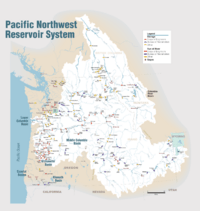Priest Rapids Dam facts for kids
Quick facts for kids Priest Rapids Dam |
|
|---|---|

The dam's spillway in June 1973.
|
|
| Location | Grant / Yakima counties, Washington |
| Coordinates | 46°38′35″N 119°54′34″W / 46.6431876°N 119.9094884°W |
| Construction began | July 1956 |
| Opening date | 1959 (First Generation) 1961 (Full Completion) |
| Dam and spillways | |
| Impounds | Columbia River |
| Height | 178 ft (54 m) |
| Length | 10,103 ft (3,079 m) |
| Reservoir | |
| Creates | Priest Rapids Lake |
| Total capacity | 237,100 acre⋅ft (0.2925 km3) |
| Power station | |
| Turbines | 10 |
| Installed capacity | 955.6 MW |
The Priest Rapids Dam is a large concrete dam on the Columbia River in Washington. It creates electricity using the power of flowing water. The dam is located between the Yakima Firing Range and the Hanford Nuclear Reservation. It connects Yakima County and Grant County.
This dam is about 24 miles south of Vantage and 47 miles northwest of Richland. It is owned by the Grant County Public Utility District (PUD). The dam is named after the "Priest Rapids," which were once fast-flowing parts of the river. These rapids are now covered by the lake behind the dam, called Priest Rapids Lake. Priest Rapids Dam is an important part of the many dams along the Columbia River.
Building the Priest Rapids Dam
The idea for the Priest Rapids Dam came after a big flood in 1949. This flood, known as the Vanport Flood, caused a lot of damage in Oregon. To help prevent future floods, the government started the Priest Rapids Project in 1950.
The United States Army Corps of Engineers first planned the project. However, they decided it was not their top priority. So, in 1952, the Grant County Public Utility District (PUD) began to take over the project. In 1955, Congress gave Grant PUD the official right to build the dam.
Construction of the dam began in July 1956. The dam started making electricity in 1959. The entire project was finished in 1961. The lake formed behind the dam is called Priest Rapids Lake. This lake stretches about 18 miles upstream to the Wanapum Dam. Downstream from Priest Rapids Dam is the Hanford Reach. This is the only part of the Columbia River in the United States that flows freely without tides or other dams.
Dam Operations and Upgrades
The original license for the dam ended in 2005. After that, Grant County PUD ran the dam with yearly license extensions. They were working to get a longer license. In 2008, the Federal Energy Regulatory Commission approved a new license. This license allows the dam to operate for another 44 years. It also includes the nearby Wanapum Dam.
The new license came with several important conditions. These conditions help make sure the dam operates safely and responsibly. They also protect the environment and local history.
- Modernizing Power: The dam's equipment for making electricity needed to be updated.
- Water Quality: Programs were put in place to check and improve the water quality.
- Wildlife Protection: Efforts were made to improve places where wildlife lives.
- Protecting History: Nearly 700 important historical sites of the Wanapum Tribe are near the dam. The license requires protecting these sites.
- Improving Recreation: New places for camping, picnics, and trails were added for people to enjoy.
Safety and Maintenance
Like any large structure, the Priest Rapids Dam needs regular checks and maintenance. There have been some issues over the years.
In October 2015, an incident occurred where six employees were injured. The Grant County PUD was later fined for safety issues related to this event.
Also, small leaks have been found in parts of the dam's spillway. A "non-failure emergency" was announced because of these leaks. This meant the dam was not in danger of breaking, but it needed attention. As a safety step, the water level behind the dam was lowered by about three feet. This allowed workers to inspect and fix the leaks.


